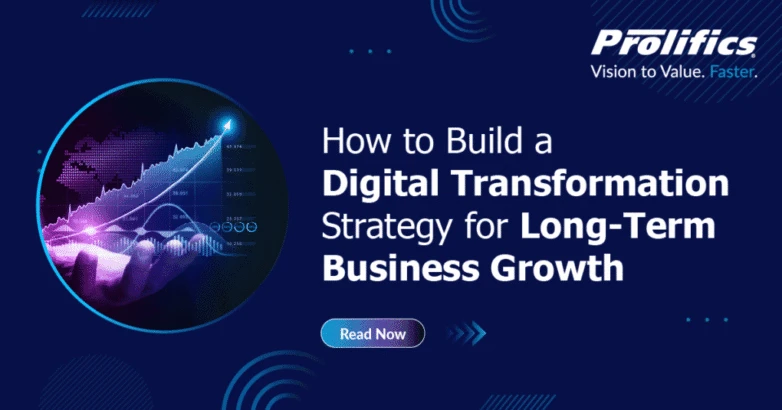Organizations are increasingly investing in digital transformation strategy to strengthen their competitive advantage, drive innovation, and ensure business growth with digital transformation.
To stay competitive, agile, and customer-centric, companies are adopting digital tools, automation, and AI in digital transformation. But transformation isn’t just about using the latest technologies—it’s about reshaping business models, rethinking operations, and reimagining customer experiences.
According to the latest update to the International Data Corporation (IDC) Worldwide Digital Transformation Spending Guide, worldwide spending on Digital Transformation (DX) is forecast to reach almost $4 trillion in 2027. With artificial intelligence (AI) and Generative AI pushing investments, the DX market is forecast to grow with a compound annual growth rate (CAGR) of 16.2% over the 2022-2027 period.
A successful digital transformation strategy must be both visionary and actionable. This blog walks you through the key steps to build a transformation strategy that delivers long-term value and real impact.
The Basics of Digital Transformation
Digital transformation is the process of integrating digital technologies into all aspects of a business to fundamentally change how it operates and delivers value. It spans across processes, customer interactions, data usage, and organizational culture.
At its core, digital transformation involves:
1. Adopting cloud-based and data-driven solutions
2. Automating business processes
3. Enhancing user experiences with personalization
4. Building flexible, scalable IT infrastructures
5. Shifting to agile and innovation-driven mindsets
Digital transformation isn’t a one-time project—it’s a continuous evolution aligned with customer needs and business goals.
A Successful Digital Transformation Strategy Meets Customers Where They Are
Every transformation strategy should begin with the customer. Today’s consumers expect seamless digital experiences—whether shopping online, accessing healthcare, or using government services.
A customer-centric approach includes:
1. Mapping the customer journey to identify pain points and friction
2. Leveraging data analytics to understand behaviors and preferences
3. Prioritizing mobile-first and omnichannel experiences
4. Creating self-service options and AI-powered support tools
By designing transformation initiatives around real customer needs, organizations can increase loyalty, satisfaction, and lifetime value.
Assess Your Digital Maturity
A digital maturity assessment evaluates your current capabilities across technology, people, and processes. It helps identify gaps, risks, and growth opportunities.
Key areas to assess:
1. Technology readiness: Are your systems integrated, scalable, and secure?
2. Workforce agility: Do employees have the skills and tools to innovate?
3. Data maturity: Are you effectively using data for decision-making and personalization?
4. Culture: Is your organization open to change and innovation?
Use maturity models or benchmarking tools to get an objective view. This assessment will form the baseline for your transformation roadmap.
Create a Transformation Roadmap
With a clear view of your current state and future goals, the next step is to build a structured roadmap. A digital transformation roadmap outlines the initiatives, timelines, resources, and metrics required to achieve your objectives.
Tips for creating a strong roadmap:
1. Prioritize initiatives: Focus on quick wins and high-impact projects first
2. Set measurable goals: Use KPIs like customer retention, process efficiency, and ROI
3. Define roles and responsibilities: Cross-functional collaboration is essential
4. Include governance models: Ensure accountability and alignment
Before Implementing Your Roadmap, Consider Your Brand Experience
Your digital transformation should not compromise your brand identity—in fact, it should amplify it. Every digital touchpoint should consistently reflect your brand’s promise, values, and personality.
Evaluate:
1. User experience design: Are your digital assets intuitive, accessible, and aesthetically aligned?
2. Voice and tone: Is your brand messaging consistent across channels?
3. Customer trust: Are you prioritizing data privacy and transparency?
A seamless, branded digital experience builds emotional connections with users and distinguishes your business in a crowded digital marketplace.
Monitor and Evaluate Your Digital Transformation Strategy for Transformative Impact
Successful transformation is measured in outcomes, not effort. Regular monitoring and evaluation allow you to course-correct, adapt to changes, and prove ROI.
Best practices:
1. Establish key performance indicators (KPIs): Tie metrics to business goals, such as revenue growth, customer engagement, or time-to-market
2. Use analytics and dashboards: Get real-time insights into performance
3. Conduct feedback loops: Involve employees and customers in the evaluation process
4. Iterate continuously: Treat transformation as an agile, ongoing journey
Organizations that consistently monitor and improve their strategies can stay ahead of disruption and maintain a competitive edge.
Pick the Right Digital Transformation Consulting Partner
Even the most visionary strategy can fall flat without the right expertise. A seasoned digital transformation consulting partner can help you navigate complexities, avoid pitfalls, and accelerate success.
When selecting a partner, consider:
1. Industry experience: Do they understand your specific challenges and regulations?
2. Technology capabilities: Can they deliver across cloud, AI, automation, and data?
3. Change management expertise: Can they support cultural shifts and training?
4. Proven track record: Have they delivered results for similar clients?
Conclusion
As digital transformation becomes core to the business strategy, 40 per cent of IT leaders will rise as business leaders by 2027, aligning people, operations and business models with digital technologies, according to the Worldwide Digital Business and AI Transformation 2025 Predictions.
Creating a successful digital transformation strategy requires more than just adopting new technologies—it demands a deep understanding of your customers, your business goals, and your organizational capabilities.
Start with a clear vision grounded in customer needs. Assess your digital maturity, build a detailed roadmap, and align your digital experiences with your brand. Continually monitor progress and refine your approach. And most importantly, surround yourself with experts who can guide you every step of the way.
At Prolifics, we help businesses design and implement end-to-end transformation strategies that drive innovation, agility, and measurable growth. Whether you’re just starting or refining your digital journey, our experts are here to guide you every step of the way.
Let’s build your future—together. Contact Us for a free consultation today.




